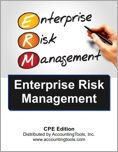Enterprise Risk Management (CPE Course)
CPE Credit: 11 hours
Course Type: Downloaded PDF materials with online test
Price (with PDF Textbook): $70
Course Description
A well-run business needs to factor risk into its daily operations in order to keep from incurring unexpected losses. This course provides detailed guidance for doing so. Enterprise Risk Management describes the concept of risk management, how to identify risks, and how to prioritize the responses to these risks. The course also shows how to integrate risk management into an organization’s strategy and day-to-day operations, and who is responsible for it. The course addresses risk management at the level of the individual functional area, including treasury and accounting, sales and marketing, human resources, and information technology. There is coverage of contingency planning, insurance, financial analysis, and risk-related measurements and reports. Risk management is a major failing in many organizations; use the planning advice in this course to rise above the crowd.
Author: Steven Bragg
Course Number: FN1020
Table of Contents
Chapter 1. Risk Management Overview
Chapter 2. Treasury Risk Management
Chapter 3. Sales and Marketing Risk Management
Chapter 4. Supply Chain Risk Management
Chapter 5. Production and Distribution Risk Management
Chapter 6. Human Resources Risk Management
Chapter 7. Accounting Risk Management
Chapter 8. Information Technology and Systems Risk Management
Chapter 9. Other Risk Management Topics
Chapter 10. Contingency Planning
Chapter 11. Insurance
Chapter 12. Risk in Financial Analysis
Chapter 13. Risk Measurements and Reports
Learning Objectives
Recognize the benefits of risk management, the circumstances under which an organization can retain risk, the characteristics of an enterprise risk management system, and the contents of an organization’s risk profile.
Specify the contents of a credit rating system, and the circumstances under which operational hedges, forward contracts, payment netting, call options, and interest rate swaptions are used.
Identify the risk mitigation efforts that can benefit from centralized marketing management and product testing, as well as the tactics used to mitigate the risk of false marketing claims.
Specify the uses of surety bonds, as well as the available risk mitigation alternatives for late deliveries.
Recognize the alternatives available to reduce the risks of insufficient capacity.
Identify the risk-related benefits of offering a richer benefits package to employees, as well as the options available for offsetting a decline in employee morale.
Identify the uses to which multiple scenario modeling and internal audits can be put, as well ashow to reduce the risk of issuing financial statements that contain errors.
Recognize which risk can be reduced by the use of a hot site, and the risk represented by portable storage media.
Specify the risk mitigation tactics related to political risk and alliance risk.
Identify the employee notification systems that can be used in the event of an emergency, which forms of communication are the most effective, and which issues with employees may arise immediately after a disaster has occurred.
Recognize the reasons why deductibles and co-pay are included in insurance contracts, the issues with all-perils coverage, and the circumstances under which reimbursement occurs under business interruption insurance.
State how risk should be incorporated into analyses involving pricing, dividends, capital budgeting, and research & development.
Identify the uses to which risk-related reports can be put, the types of leading indicators, and how to evaluate credit ratings.
Level: Overview
Instructional Method: QAS Self-Study
NASBA Category: Management Services
Prerequisites: None
Advance Preparation: None
Latest Review Date: June 2024
Program Registration Requirements: Click on "Purchase Course" near the top of this page to pay for and access the course. You will then be able to download the course as a PDF file, then take an on-line examination, and then download a certificate of completion if you pass the examination.
Program Refund Policy: For more information regarding administrative policies concerning complaints, refunds, and other matters, see our policies page.
AccountingTools, Inc. is registered with the National Association of State Boards of Accountancy (NASBA) as a sponsor of continuing professional education on the National Registry of CPE Sponsors. State boards of accountancy have the final authority on the acceptance of individual courses for CPE credit. Complaints regarding registered sponsors may be submitted to the National Registry of CPE Sponsors through its website: www.nasbaregistry.org.
The NASBA sponsor identification number for Accountingtools, Inc. is 115881.
AccountingTools is an IRS Approved Continuing Education Provider. We are compliant with the requirements for continuing education providers (as described in sections 10.6 and 10.9 of the Department of Treasury’s Circular No. 230 and in other IRS guidance, forms, and instructions). Our IRS Approved Continuing Education Provider number is 72821.


